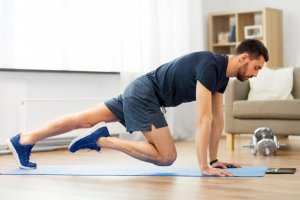Why is it Important to Exercise During Isolation?

There are many reasons why a person may be in isolation. Considering the current worldwide situation, the expansion of the COVID-19 pandemic (coronavirus) is the most significant argument to stay inside your home. But exercise shouldn’t stop during isolation.
It doesn’t matter if the isolation is only preventive or imposed by government entities, you should follow it consciously. Avoid any contact with people residing in different homes.
What is isolation?
Broadly speaking, isolation means staying away from the environment in which people are normally immersed in. This includes other individuals, chores and all kinds of common habits.
Social isolation can be involuntary and bring negative consequences for our bodies on psychological and physical levels. However, in regard to COVID-19, isolation is voluntary under the orders of local governments.
Regardless of the type of isolation (voluntary or involuntary), the negative consequences can affect us widely. In the following paragraphs, we’ll analyze the relationship between being in isolation and physical exercise.
Exercise during isolation
Preventive isolation measures can influence most people in a negative way. One of these ways is by causing a sedentary lifestyle.
Therefore, the main recommendation revolves around exercising at home. This way, it becomes possible to prevent the harmful effects that come with a sedentary lifestyle.

What is a sedentary lifestyle?
Also known as physical inactivity, a sedentary lifestyle is one of the main problems of the 21st century. According to the World Health Organization (WHO), at least 60 percent of the world population doesn’t have as much physical activity as they should.
The idea here is to prevent the quarantine from making us fall into improper habits such as a sedentary lifestyle. That’s why exercising during isolation is an advisable measure.
The importance of exercise during isolation
The most important argument for exercising during isolation is, as we already mentioned, the prevention of a sedentary lifestyle. When we fall into this practice, we enter a phase of physical deconditioning, as well as other alterations on an emotional level.
Food intake
On top of physical inactivity, excessive caloric intake can also start to create havoc in our body. For this reason, home exercise routines should be an essential habit during isolation.
The recommendation, in this case, is to look for exercise routines of at least 30 minutes and implement them throughout the day. If you don’t know much about this subject, you may need to consult with fitness professionals online or by telephone.
It’s also important to avoid highly processed foods or products with a higher caloric load than what you need.
Emotional disturbances due to isolation
The importance of exercising doesn’t rest solely on physical appearance or weight gain. Social isolation often affects many people, causing them emotional problems.
The body and mind must work together to create an adequate balance regarding the health of the individual. Coping with the ravages of isolation is the real goal, and that’s where the importance of exercising at home lies.
When physical inactivity takes its toll on the mind, stress and anxiety are the first to appear. This is due to the hormonal alterations that occur in situations in which we are under zero social contact.
Hormonal disturbances
The neuroendocrine system is in charge of releasing hormones to counteract reactions in the body caused by situations of mild stress. However, when those situations exceed the common indices, hormonal alterations may occur.
Since isolation is a possible trigger for excessive stress due to panic or fear, the body is prone to suffer from these disorders. One of the main hormones that our body produces without control is cortisol. Under normal circumstances, cortisol is responsible for performing different metabolic tasks that lead to homeostasis in the body.

However, when we produce the ‘stress hormone’ in abnormal amounts, it can cause symptoms that have noticeable effects on our body; headaches, fatigue, hypertension, muscle pain, cramps, lack of appetite, among others, are some examples.
Conclusion: it’s important to exercise during isolation
Based on all of the information above, we can perceive that social isolation widely affects various aspects of the body. It can compromise both physical and emotional health. Therefore, exercising is a great alternative to mitigate these problems.
Dealing with and respecting the COVID-19 (coronavirus) isolation is everyone’s responsibility. Despite being locked up at home, activity and physical exercise shouldn’t stop.
There are many reasons why a person may be in isolation. Considering the current worldwide situation, the expansion of the COVID-19 pandemic (coronavirus) is the most significant argument to stay inside your home. But exercise shouldn’t stop during isolation.
It doesn’t matter if the isolation is only preventive or imposed by government entities, you should follow it consciously. Avoid any contact with people residing in different homes.
What is isolation?
Broadly speaking, isolation means staying away from the environment in which people are normally immersed in. This includes other individuals, chores and all kinds of common habits.
Social isolation can be involuntary and bring negative consequences for our bodies on psychological and physical levels. However, in regard to COVID-19, isolation is voluntary under the orders of local governments.
Regardless of the type of isolation (voluntary or involuntary), the negative consequences can affect us widely. In the following paragraphs, we’ll analyze the relationship between being in isolation and physical exercise.
Exercise during isolation
Preventive isolation measures can influence most people in a negative way. One of these ways is by causing a sedentary lifestyle.
Therefore, the main recommendation revolves around exercising at home. This way, it becomes possible to prevent the harmful effects that come with a sedentary lifestyle.

What is a sedentary lifestyle?
Also known as physical inactivity, a sedentary lifestyle is one of the main problems of the 21st century. According to the World Health Organization (WHO), at least 60 percent of the world population doesn’t have as much physical activity as they should.
The idea here is to prevent the quarantine from making us fall into improper habits such as a sedentary lifestyle. That’s why exercising during isolation is an advisable measure.
The importance of exercise during isolation
The most important argument for exercising during isolation is, as we already mentioned, the prevention of a sedentary lifestyle. When we fall into this practice, we enter a phase of physical deconditioning, as well as other alterations on an emotional level.
Food intake
On top of physical inactivity, excessive caloric intake can also start to create havoc in our body. For this reason, home exercise routines should be an essential habit during isolation.
The recommendation, in this case, is to look for exercise routines of at least 30 minutes and implement them throughout the day. If you don’t know much about this subject, you may need to consult with fitness professionals online or by telephone.
It’s also important to avoid highly processed foods or products with a higher caloric load than what you need.
Emotional disturbances due to isolation
The importance of exercising doesn’t rest solely on physical appearance or weight gain. Social isolation often affects many people, causing them emotional problems.
The body and mind must work together to create an adequate balance regarding the health of the individual. Coping with the ravages of isolation is the real goal, and that’s where the importance of exercising at home lies.
When physical inactivity takes its toll on the mind, stress and anxiety are the first to appear. This is due to the hormonal alterations that occur in situations in which we are under zero social contact.
Hormonal disturbances
The neuroendocrine system is in charge of releasing hormones to counteract reactions in the body caused by situations of mild stress. However, when those situations exceed the common indices, hormonal alterations may occur.
Since isolation is a possible trigger for excessive stress due to panic or fear, the body is prone to suffer from these disorders. One of the main hormones that our body produces without control is cortisol. Under normal circumstances, cortisol is responsible for performing different metabolic tasks that lead to homeostasis in the body.

However, when we produce the ‘stress hormone’ in abnormal amounts, it can cause symptoms that have noticeable effects on our body; headaches, fatigue, hypertension, muscle pain, cramps, lack of appetite, among others, are some examples.
Conclusion: it’s important to exercise during isolation
Based on all of the information above, we can perceive that social isolation widely affects various aspects of the body. It can compromise both physical and emotional health. Therefore, exercising is a great alternative to mitigate these problems.
Dealing with and respecting the COVID-19 (coronavirus) isolation is everyone’s responsibility. Despite being locked up at home, activity and physical exercise shouldn’t stop.
All cited sources were thoroughly reviewed by our team to ensure their quality, reliability, currency, and validity. The bibliography of this article was considered reliable and of academic or scientific accuracy.
- Ledermann Dehnhardt, W. (1996). El hombre y sus epidemias a través de la historia. Rev. Chil. Infectol.
- Andradas Aragonés, E., Merino Merino, B., Campos Esteban, P., Justo Gil, S., Gil Luciano, A., Zuza Santacilia, I., Terol Claramonte, M., & Santaolaya Cesteros, M. (2015). Actividad física para la salud y reducción del sedentarismo. Ministerio de Sanidad, Servicios Sociales e Igualdad.
- Pineda, C. A. (2008). Metabolic syndrome: Definition, history, criterion. Colombia Medica.
This text is provided for informational purposes only and does not replace consultation with a professional. If in doubt, consult your specialist.








